Natural Solutions to Things That Bug You (28 page)
Read Natural Solutions to Things That Bug You Online
Authors: Myles Bader

Guinea hens are one of the best grasshopper catchers around. They will patrol your garden and eliminate the hopper problem. When they have cleared the area, cage them!
IMPORTED CABBAGEWORM
Identification:
 One of the more common cabbageworms is the Imported Cabbageworm. The adult is a small white butterfly that has black-tipped forewings, which has a span of about 1½- inches. The males having 1 black spot on top of their wings and the females have 2 black spots. The hind wings are all white with a black spot.
One of the more common cabbageworms is the Imported Cabbageworm. The adult is a small white butterfly that has black-tipped forewings, which has a span of about 1½- inches. The males having 1 black spot on top of their wings and the females have 2 black spots. The hind wings are all white with a black spot.
Their eggs are laid on the underneath side of leaves and are a yellowish color. It is best to crush the eggs when found to reduce the number of larvae.
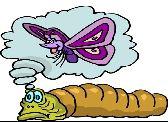 Their larvae are a velvety green with faint yellow stripes. The larvae are about 1 inch long, green with a yellow stripe down their back and love to eat leaves. Those common white butterflies come from this caterpillar.
Their larvae are a velvety green with faint yellow stripes. The larvae are about 1 inch long, green with a yellow stripe down their back and love to eat leaves. Those common white butterflies come from this caterpillar.
STANDARD CATERPILLAR CONTROL
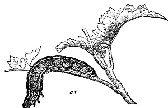 Very effective control can be achieved if you release trichogramma and lacewings, or spray or dust with Bt or NPV. You can also handpick the larvae off plants and then use a butterfly net to catch the butterflies. If you plant rosemary, thyme or sage in your garden they will stay away. A Bt spray is also very effective.
Very effective control can be achieved if you release trichogramma and lacewings, or spray or dust with Bt or NPV. You can also handpick the larvae off plants and then use a butterfly net to catch the butterflies. If you plant rosemary, thyme or sage in your garden they will stay away. A Bt spray is also very effective.
LEAFROLLERS
Identification:
 The forewings are usually walnut brown to a light tan in color. These moths are active at night. Their eggs are usually very hard to spot since they are the same color as a leaf.
The forewings are usually walnut brown to a light tan in color. These moths are active at night. Their eggs are usually very hard to spot since they are the same color as a leaf.
General Information:
The caterpillars may spin their web in leaves and then roll them up making them easier to spot. They will infest large numbers of leaves and can do a lot of damage. They are not too fussy and will use plant leaves if a tree is not handy.
BEST TO SPRAY
One of the best methods for these caterpillars is to spray them with Bt, then use a mixture of NVP or soap and lime spray. An alternative method would be to release lacewings and trichogramma to destroy the eggs.
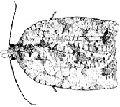
MITES
Identification:
They are grayish black to red and their mouthparts are all grouped in the front of their body, which looks like their head. The adults have four pairs of legs and are very slow moving. They may look like a little moving spot (about the size of a grain of salt). They only measure 1/100
of an inch. They have eight pairs of legs and have no wings or antennae. They can be found in water, on land and in the air.
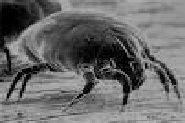
General Information:
There are over 40,000 species worldwide and 50% of them live as parasites on animals. The most common ones we encounter is the house dust mite who usually inhabits the folds in mattresses waiting for a meal of dead skin to munch on. They cause numerous allergies and may even cause asthmatic attacks. Mites are distant relatives of spiders.
Spider Mites
One of the more common mites is the spider mite especially in the urban landscape and can inflict serious damage to trees, shrubs and flowers. Both evergreen and deciduous plants may be attacked. Spider mites are not insects but they are more closely related to ticks and spiders and their name is derived from their ability to produce silk, which most species spin on host plants. Mites are tiny, about the size of the period at the end of this sentence. They are very prolific, which is why infestations usually go unnoticed until plants exhibit significant damage.
Spider mites have a simple, oval-shaped body and no wings or antennae. All species pass through an egg stage, six-legged larval stage and two eight-legged nymph stages before transforming into an eight-legged adult. The immature stages resemble the adults except in size and an adult female may live for several weeks and lay many dozens of eggs during her lifetime.
Under optimum conditions, spider mites can complete their development from egg to adult in less than one week, so there may be many overlapping generations in a single season. Therefore, populations increase rapidly and can cause extensive plant damage in short period of time.
Spider mites possess needle-like mouthparts and feed by piercing the leaves of host plants and sucking out the fluids from individual plant cells. This causes the leaves to have a stippled or flecked appearance, with pale dots where the cellular contents have been removed. Most of the mites feed from the undersides of leaves, although the damage is most evident from the upper surface.
Most spider mites have a habit of covering leaves, shoots, and flowers with very fine silken webbing, produced from a pair of glands near the mouth. The silk strands aid in dispersal by allowing the mites to spin down from infested to non-infested leaves, and to be blown by wind currents. When abundant, the silk also may shield the mites from pesticide sprays.
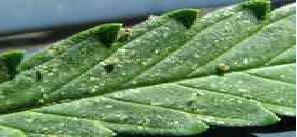
Spider mites are one of the more difficult landscape pests to control; however, infestations are easier to control when detected early, before the populations have reached very high levels. Spider mite infestations can often be traced to the purchase of infested plant material. When purchasing new plants; always inspect the lower leaf surfaces for evidence of mites.
An efficient way to sample vegetation for spider mites is to hold a sheet of white paper under a branch and tap the foliage sharply. If spider mites are present, they will be dislodged and look like slow- moving, dark specks on the paper.
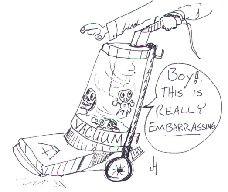
VACUUM, VACUUM, VACUUM
The best method of reducing the mite population or eliminating the problem it is to vacuum regularly.
NOT TOO MITEY AFTER THIS
Mix 2 tablespoons of cayenne pepper or a very hot, spicy sauce with 3-4 drop of Ivory Liquid Soap™ in 1 quart of tap water. Mix well, then place into a spray bottle and spray plants making sure that you spray the underneath sides of the leaves well. Make sure that the mixture stays in solution by shaking the bottle frequently.